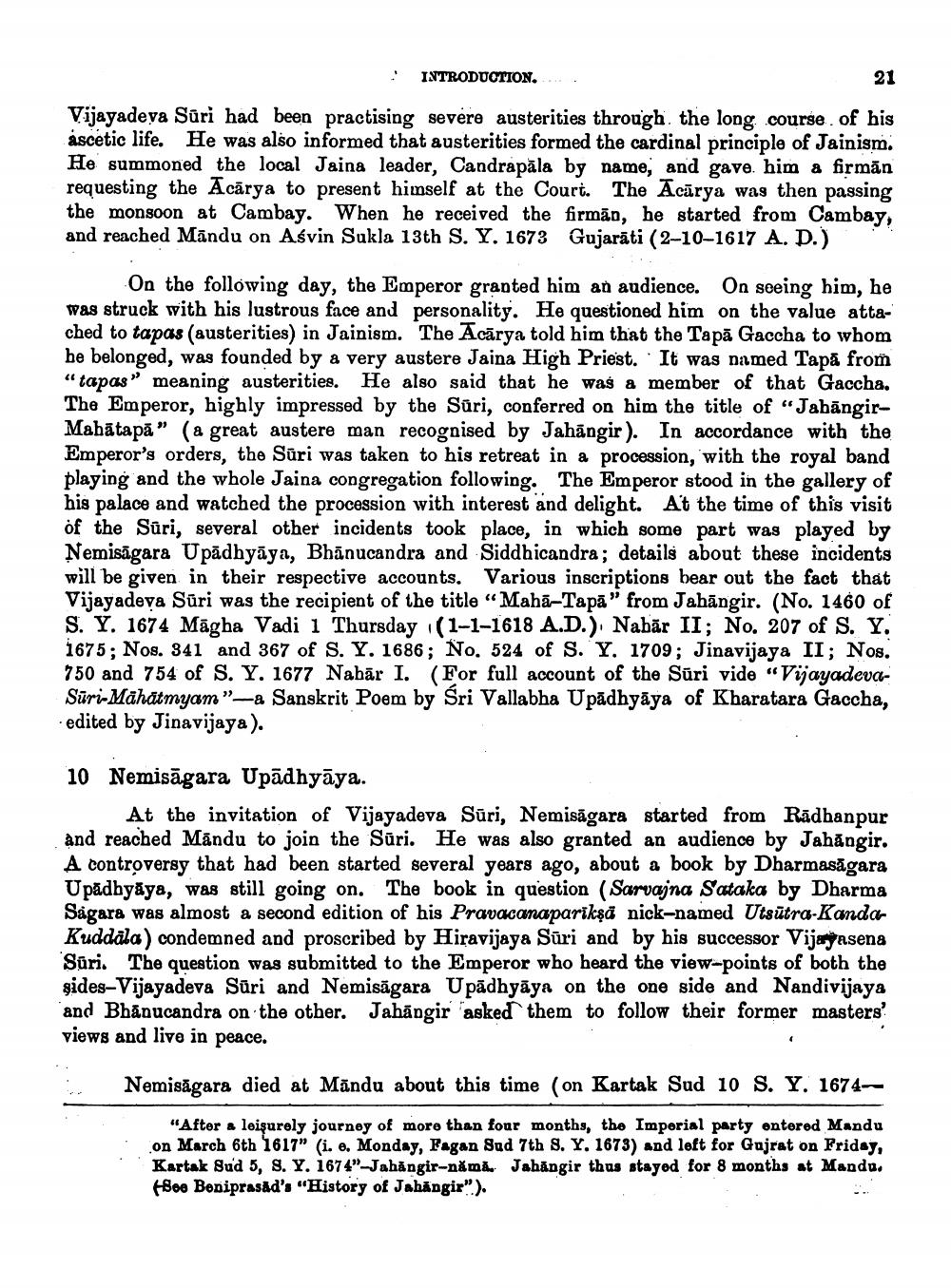________________
21
Vijayadeva Sari had been practising severe austerities through the long course of his ascetic life. He was also informed that austerities formed the cardinal principle of Jainism. He summoned the local Jaina leader, Candrapala by name, and gave him a firmăn requesting the Acarya to present himself at the Court. The Acarya was then passing the monsoon at Cambay. When he received the firmän, he started from Cambay, and reached Mandu on Asvin Sukla 13th S. Y. 1673 Gujarati (2-10-1617 A. D.)
: INTRODUCTION.
On the following day, the Emperor granted him an audience. On soeing him, he was struck with his lustrous face and personality. He questioned him on the value attached to tapas (austerities) in Jainism. The Acarya told him that the Tapă Gaccha to whom he belonged, was founded by a very austere Jaina High Priest. It was named Tapă from "tapas" meaning austerities. He also said that he was a member of that Gaccha, The Emperor, highly impressed by the Süri, conferred on him the title of "JahangirMahatapa" (a great austere man recognised by Jahangir). In accordance with the Emperor's orders, the Suri was taken to his retreat in a procession, with the royal band playing and the whole Jaina congregation following. The Emperor stood in the gallery of his palace and watched the procession with interest and delight. At the time of this visit of the Süri, several other incidents took place, in which some part was played by Nemisägara Upadhyaya, Bhanucandra and Siddhicandra; details about these incidents will be given in their respective accounts. Various inscriptions bear out the fact that Vijayadeva Suri was the recipient of the title "Maha-Tapa" from Jahangir. (No. 1460 of S. Y. 1674 Magha Vadi 1 Thursday (1-1-1618 A.D.). Nabar II; No. 207 of S. Y. 1675; Nos. 341 and 367 of S. Y. 1686; No. 524 of S. Y. 1709; Jinavijaya II; Nos. 750 and 754 of S. Y. 1677 Nabar I. (For full account of the Suri vide "VijayadevaSari-Mahatmyam"-a Sanskrit Poem by Sri Vallabha Upadhyaya of Kharatara Gaccha, edited by Jinavijaya).
10 Nemisagara Upadhyāya.
At the invitation of Vijayadeva Süri, Nemisägara started from Radhanpur and reached Mandu to join the Süri. He was also granted an audience by Jahangir. A controversy that had been started several years ago, about a book by Dharmasagara Upadhyaya, was still going on. The book in question (Sarvajna Sataka by Dharma Ságara was almost a second edition of his Pravacanaparikad nick-named Utsutra-KandaKuddala) condemned and proscribed by Hiravijaya Suri and by his successor Vijayasena Sari. The question was submitted to the Emperor who heard the view-points of both the sides-Vijayadeva Süri and Nemisägara Upadhyaya on the one side and Nandivijaya and Bhanucandra on the other. Jahangir asked them to follow their former masters' views and live in peace.
Nemisägara died at Mandu about this time (on Kartak Sud 10 S. Y. 1674-
"After a leisurely journey of more than four months, the Imperial party entered Mandu on March 6th 1617" (i. e. Monday, Fagan Sud 7th S. Y. 1673) and left for Gujrat on Friday, Kartak Sud 5, S. Y. 1674"-Jahangir-nămă. Jahangir thus stayed for 8 months at Mandu. Bee Beniprasad's "History of Jahangir").




